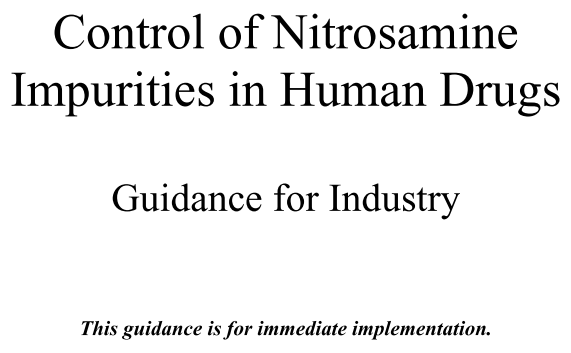9月1日,美国FDA发布一项有关亚硝胺杂质的指南,名为"人药亚硝胺杂质的控制"。该指南介绍亚硝胺杂质引入的能条件,针对原料药和制剂生产商应采取措施提出了建议,以检测和防止亚硝胺杂质含量超出可接受水平。

对于本指南,FDA 表示,“最近在血管紧张素 II 受体阻滞剂、雷尼替丁、尼扎替丁、二甲双胍、利福平和利福喷丁等药物中,都发现了亚硝胺杂质,清楚地说明了执行风险管理策略的必要性,以识别和降低亚硝胺在药品中存在风险” 。该指南是FDA有关硝胺杂质问题至今为止为详细的一份文件,其建议适用于所有化学合成的API和含化学合成API的制剂。
该指南立即生效,反映了FDA认为亚硝胺杂质问题的紧迫性。
该指南共有24页,正文分为五个部分,分别是:(1)介绍、(2)背景、(3)建议项、(4)维护药物供应和(5)向FDA报告变更。
PharmLink指南组对正文主要内容进行翻译,供大家参考。
I . INTRODUCTION 简介
This guidance recommends steps manufacturers of APIs and drug products should take to detect and prevent unacceptable levels of nitrosamine impurities in pharmaceutical products. The guidance also describes conditions that may introduce nitrosamine impurities. The recent unexpected finding of nitrosamine impurities, which are probable human carcinogens, in drugs such as angiotensin II receptor blockers (ARBs), ranitidine, nizatidine, and metformin, has made clear the need for a risk assessment strategy for potential nitrosamines in any pharmaceutical product at risk for their presence.
本指南建议原料药和药品生产商应采取的步骤,以检测和防止药品中亚硝胺杂质含量超标。该指南还介绍了可能引入亚硝胺杂质的条件。最近在血管紧张素II受体阻滞剂(ARB)、雷尼替丁、尼扎替丁和二甲双胍等药物中发现了可能是人类致癌物的亚硝胺杂质,这清楚地表明了,对于任何存在风险的药品,进行潜在亚硝胺风险评估策略的必要性。
The discovery of nitrosamines in some types of drug products led FDA and other international regulators to conduct a detailed analysis of these impurities in affected APIs and drug products. Based on the Agency’s current understanding, this guidance discusses potential root causes of nitrosamine formation and advises API and drug product manufacturers that they should (1) conduct risk assessments of their approved or marketed products and products with pending applications, and (2) take appropriate actions to reduce or prevent the presence of nitrosamines in APIs and drug products.
在某些类型的药物中,发现了亚硝胺,这些杂质对API和药品的影响,导致FDA和其他国际监管机构对其进行了详细分析。根据FDA的当前理解,本指南讨论了亚硝胺形成的潜在根本原因,并告知原料药和药品生产商,他们应:
(1)对批准的或市售产品和待批准产品进行风险评估
(2)采取适当措施,减少或防止原料药和药品中亚硝胺的存在。
Although nitrosamine impurities have been found in only some drug products, and batches of those products have been recalled when there were unacceptable levels of these impurities, nitrosamine impurities might exist in other APIs and drug products due to use of vulnerable processes and materials that may produce nitrosamine impurities. Therefore, the recommendations made in this guidance apply to all chemically synthesized APIs. They also apply to drug products containing chemically synthesized APIs and to drug products at risk due to other factors described in this guidance (see sections II.B and C), and not just to the drug products that have been identified in FDA announcements.
尽管仅在某些药品中发现了亚硝胺杂质,且当这些杂质的含量不可接受时,已召回了这些产品的批次,但由于脆弱的工艺和使用可能产生杂质的物质,其他原料药和药品中也可能存在亚硝胺杂质。因此,本指南中的建议适用于所有化学合成的API,还适用于含化学合成API的药品,以及由于本指南中所述的其他因素而有风险的药品(请参见II.B和C节),而不仅限于FDA公告中已确认的药品。
In general, FDA’s guidance documents do not establish legally enforceable responsibilities. Instead, guidances describe the Agency’s current thinking on a topic and should be viewed only as recommendations, unless specific regulatory or statutory requirements are cited. The use of the word should in Agency guidances means that something is suggested or recommended, but not required.
通常,FDA的指南没有确立法律上可执行的责任。相反,指南描述了FDA当前对某个主题的想法,除非引用了特定的监管或法规要求,否则仅应被视为建议。在FDA指南中使用“应”一词的意思是建议或推荐某事,但不是必需的。
关于举办2026年度四川省药品生产企业质
各药品生产企业: 2026年是我国..四川省医药保化品质量管理协会召开第七
2025年12月17日,四川省医药保化品..协会党支部组织党日主题学习会
协会党支部组织党日主题学习会 --..协会党支部组织党日主题学习会
协会党支部组织党日主题学习会 --..四川省医药保化品质量管理协会党支部开
为庆祝中国共产党成立104周年,持..四川省医药保化品质量管理协会党支部召
四川省医药保化品质量管理协会党支..四川省医药保化品质量管理协会党支部召
四川省医药保化品质量管理协会党支..关于相关收费标准的公示
根据四川省医药保化品质量管理协会..关于收取2025年度会费的通知
各会员单位: 在过去的一年里,..“两新联万家,党建助振兴”甘孜行活动
为深入贯彻落实省委两新工委、省市..四川省应对新型冠状病毒肺炎疫情应急指
四川省应对新型冠状病毒肺炎疫情应..四川省应对新型冠状病毒肺炎疫情应急指
四川省应对新型冠状病毒肺炎疫情应..